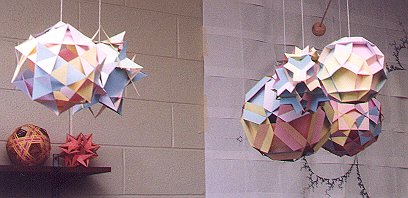Slide - Togethers
This is a good classroom activity. I have done some with middle-school students at the Goudreau Museum, and my 8-year old daughter had no trouble making the one with thirty squares. They are listed in increasing order of construction difficulty, so if you want to make your own or try this in a class, I suggest starting with the triangle one, then working down the page.
Each is made from identical copies of a single type of regular polygon
(e.g., just triangles or just squares) with slits cut at the proper locations.
I made them from pastel-colored card stock, simply photocopying my templates
onto the sheets. In most cases, glue is not needed if you use a stiff stock.
But you might want to use just a small dot of glue on some to hold the
corners together. The colorings I chose
are the 6-color pattern of the dodecahedron
and 5-color patterns of the icosahedron
or rhombic triacontahedron,
but they also look good in monochrome.
| The one at right is the easiest to make; it is constructed from twenty
equilateral triangles. (You can click on the picture to get a virtual
model.) The edges of the triangles form prominent stars (pentagrams).
To make your own, print out and photocopy this
template onto stiff paper. (Incidentally, this construction contains
all the edges of the compound of
five cubes. This is very easy to see if you slowly spin the virtual
model.)
If the pentagrams were included with the triangles, this would be a small triambic icosidodecahedron. Leaving the pentagrams open like this lets you look through to better understand the interior. The same triangles are also part of the great triambic icosidodecahedron which contains large pentagons in addition to the triangles. |
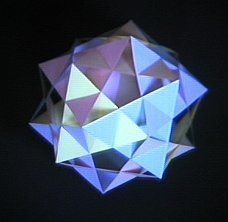 |
| This second construction is made of 30 squares, the squares of the rhombicosahedron or the rhombidodecadodecahedron. Here is a virtual model. To make your own, divide a square's edges at the eight golden ratio points, cut slits like this template, and slide everything together. I made this one with 3.5 inch squares, so six fit on one 8.5 by 11 sheet of paper, and I photocopied my template onto five different-colored sheets of card stock, assembled according to the 5-colored rhombic triacontahedron. | 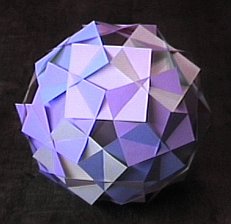 |
When assembling the squares, take care to notice the 3-way corners.
Three little trianglular tabs each lock into the next. When making
a 3-way corner, you have to bend a small tab out of the way to let the
next piece slide into place. This brings the slot into view that
the first tab locks into. Don't be afraid to bend and unbend the
paper. This same idea, but bigger tabs, applies to the more difficult
3-way corners below.
| Next is a construction made of twelve regular decagons which lie in the planes of a dodecahedron. (virtual model, template.) The edges of the decagons form pentagons, squares, and triangles. If we include the squares only, we get the small rhombidodecahedron, If we include the pentagons and triangles only, we get the small dodecicosidodecahedron. | 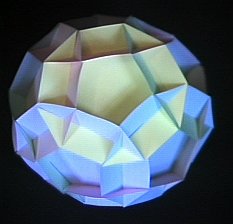 |
| A close cousin is this one, made of twelve regular pentagons. (virtual model, template.) | 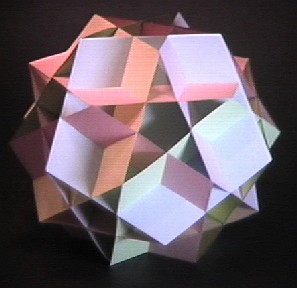 |
| Here is one made of twenty hexagons. (Virtual model, template.) This one needs just a bit of help for the parts to stay correctly positioned. You can use a little tape on the inside if you wish to be quick about it, but that would be visible if you look through the star centers. What I did instead is just to put a dot of glue at the hexagon vertices so the vertices remain in contact. This is part of the small dodecicosahedron and the small_icosic_icosidodecahedron. | 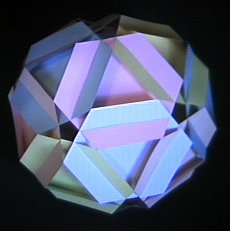 |
| This next is made of twelve star decagons (10/3-gons). (Virtual model, template.) This is a subset of the faces of the great rhombidodecahedron and the great dodecicosidodecahedron. | 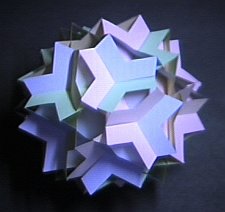 |
| And finally, a construction of twelve pentagrams. (Virtual model, template.) This is the most difficult of these examples to assemble. This is part of the great dodecahemidodecahedron and the great icosidodecahedron. | 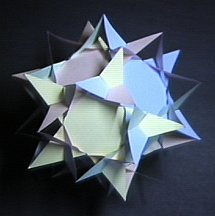 |
I have heard from one class which made the first two examples in a large size. They scaled the templates up on to large sheets of cardboard and assembled a model about five feet in diameter. If you want to make more accurate templates, in most cases the slot divides the edges in the golden ratio.
Exercise: These models are very insightful for understanding some of the uniform polyhedra. Each of the above is a subset of two different uniform polyhedra. It is actually the intersection of those two, in the sense that it is the set of faces they have in common. This implies that if you take the "symmetric difference" of those two uniform polyhedra, i.e., the set of faces which is in either one but not both, you will again have two faces meeting at each edge, and so get another uniform polyhedron. For example, combining the pentagrams of the small triambic icosidodecahedron and the pentagons of the great triambic icosidodecahedron gives the triambic dodecadodecahedron. Find or imagine the symmetric difference for the other five examples above.
Answer: The icosidodecadodecahedron, the rhombicosidodecahedron, the small dodekic icosidodecahedron, the great rhombicosidodecahedron, and the great icosihemidodecahedron.
Note: Charles Butler showed me the method for making the two with triangles and squares; the others are applications of his idea but with other uniform polyhedra.
